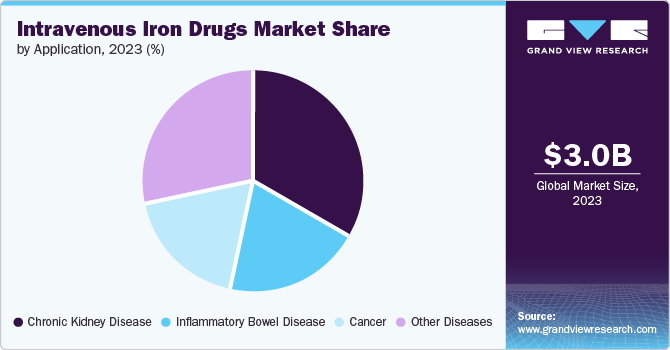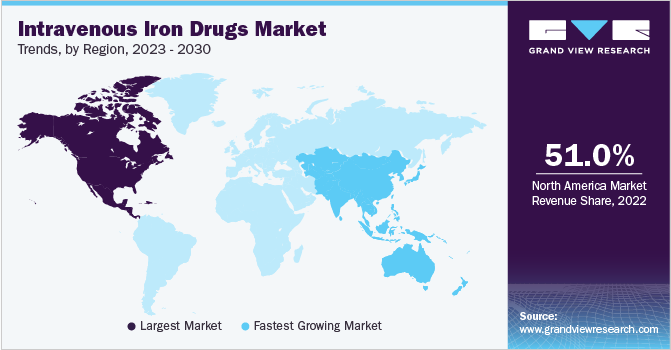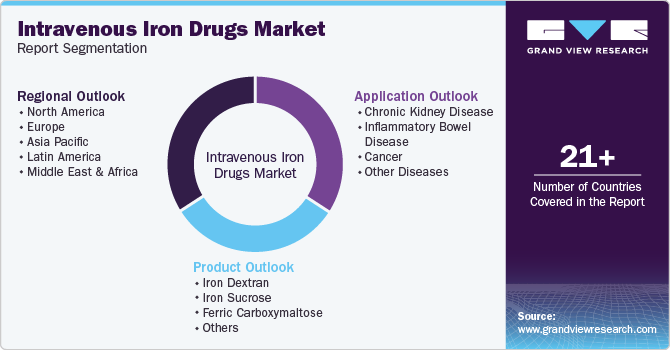- Home
- »
- Pharmaceuticals
- »
-
Intravenous Iron Drugs Market Size And Share Report, 2030GVR Report cover
![Intravenous Iron Drugs Market Size, Share & Trends Report]()
Intravenous Iron Drugs Market Size, Share & Trends Analysis Report By Product (Iron Sucrose, Iron Dextran, Ferric Carboxymaltose), By Application (Chronic Kidney Disease, Inflammatory Bowel Disease, Cancer), By Region, And Segment Forecasts, 2024 - 2030
- Report ID: GVR-4-68038-000-2
- Number of Report Pages: 100
- Format: PDF, Horizon Databook
- Historical Range: 2018 - 2023
- Forecast Period: 2024 - 2030
- Industry: Healthcare
Intravenous Iron Drugs Market Size & Trends
The global intravenous iron drugs market size was estimated at USD 3.03 billion in 2023 and is expected to expand at a CAGR of 9.2% from 2024 to 2030. Technology trends are advancing in drug delivery systems, such as nanoparticle-based formulations like injective, which enhance iron absorption and minimize side effects. These formulations offer targeted delivery mechanisms, reducing frequent dosing and adverse reactions. Innovative infusion systems and biocompatible materials are also improving the precision and reliability of IV iron therapy administration, ensuring optimal treatment outcomes for patients.

Anemia is one of the most common blood disorders in recent times. According to the National Heart, Lung, & Blood Institute, an estimated 3 million individuals suffer from anemia in the U.S. Furthermore, data from WHO indicates that approximately 42% of children below the age of 5 and 40% of pregnant women are suffering from some form of anemia. Anemia is typically seen in women, children between the ages of 1 & 2 years, individuals over the age of 65 years, and patients using blood thinners for other disorders. WHO data further indicates that an estimated one-third of women of reproductive age across the globe are anemic.
The superiority of IV treatment, comparable higher & faster absorption of intravenous drugs, lower adverse effects, and other advantages over oral drugs are increasing the adoption of IV drugs for the treatment of anemia and other target diseases. For instance, around 50% of patients having oral drugs complain of gastrointestinal adverse effects, which increased the adoption of intravenous formulations in the treatment process. Moreover, patients who have gastrointestinal bleeding or inflammatory bowel disease, patients undergoing kidney dialysis, and those with celiac disease are mostly treated with intravenous drugs.
The pandemic intensified health conditions that require intravenous iron therapy, particularly Iron Deficiency Anemia (IDA). Patients with chronic diseases, such as CKD and IBD, saw disruptions in their usual care, leading to increased use of intravenous iron as a treatment alternative when oral iron was less effective or unsuitable. During the pandemic’s peak, several non-emergency medical treatments were delayed or canceled, which initially reduced the number of administrations of intravenous iron.
For instance, in November 2022, CSL Vifor and Fresenius Kabi received approval in China for Ferinject, an intravenous iron therapy for patients with ineffective oral iron. This indicates ongoing innovation and regulatory progress despite the pandemic challenges.
Market Concentration & Characteristics
The intravenous iron drugs market exhibits a moderate range of degree of innovation and focus on enhancing the existing products. Product approvals have been limited in the market space, as there was a last product being approved in 2021. In December 2021, American Regent, Inc. and Daiichi Sankyo, Inc. announced that the U.S. FDA granted approval for Injectafer for pediatric patients with IDA who are unresponsive to oral drugs or who have exhibited an inadequate response to oral iron. Patients must at least be a year old. The suggested dosage for patients weighing below 50 kgs is two intravenous doses of Injectafer 15 mg/kg body weight at least 7 days apart for each course.
The market is experiencing moderate merger and acquisition (M&A) activity among leading players. In August 2022, CSL Limited announced that it had obtained all regulatory clearances required for the purchase of Vifor Pharma AG (Vifor), which was announced on December 14, 2021.

The regulatory trend in the intravenous iron drugs market indicates a growing emphasis on ensuring safety, efficacy, and accessibility. The compliance with regulatory requirements, such as CE marking and FDA approval, is essential for market entry. Stringent regulations drive innovation, standardization, and quality assurance, shaping dynamics and fostering trust among stakeholders.
The threat of substitutes in the intravenous iron drugs market is relatively moderate. The availability of a wide range of suppliers for Active Pharmaceutical Ingredients (APIs), excipients, tablet foils, vials, and drug packaging materials in this market is presumed to be the cause of the low bargaining power of suppliers. However, switching suppliers can be costly and time-consuming due to the need for validation and regulatory approvals.
The intravenous iron drugs market is experiencing a low level of end-user concentration. Companies are increasingly adopting strategies to expand their product reach and availability across diverse regions. For instance, in April 2024, Rockwell Medical, Inc., agreement with one of the leading health systems in the U.S. to purchase products. Under the agreement, Rockwell Medical would supply cleaning supplies, hemodialysis concentrate mixers, liquid & dry acid, bicarbonate hemodialysis concentrate, and other items that Rockwell Medical offers to this health system.
Products Insights
The ferric carboxymaltose (FCM) segment dominated the intravenous iron drugs market with a revenue share of 50.2% in 2023 due to its increasing application, superior performance coupled with fewer adverse effects, and reduced cost. FCM has greater efficacy with respect to improving hemoglobin levels and results in limited adverse events. Multiple research studies have proved that the use of FCM is safer and effective compared to other IV drugs. For instance, according to a report published by NCBI in June 2022, highly efficient, safe, and faster FCM can treat moderate-to-severe anemia in around 4 weeks.
Others segment, which includes iron isomaltoside, ferric gluconate, ferric pyrophosphate citrate, and ferumoxytol drugs, is expected to grow at a fastest CAGR over the forecast period. Some of the major players manufacturing these drugs are AMAG Pharmaceuticals, Inc.’s FeraHeme, Sanofi’s Ferrlecit, Pharmacosmos’ Monofer & Diafer, and Rockwell Medical’s TRIFERIC. Key players are increasing their market footprint by expanding the geographical presence of IV iron drugs across the globe. For instance, in January 2020, Pharmacosmos Therapeutics Inc. received U.S. FDA approval for its ferric derisomaltose injection for the treatment of iron deficiency anemia in adult patients.
Application Insights
Chronic kidney diseases accounted for the largest market share of 33.2% in 2023 due to the wide use of IV products to treat CKD-induced anemia. One standard treatment for managing anemia in CKD patients is the administration of IV drugs. These medications are crucial because they provide the iron required for the synthesis of hemoglobin, thereby addressing one of the core problems of anemia in CKD. Moreover, effective anemia management in CKD patients can slow the progression of kidney disease and decrease hospitalization, contributing to the overall management of CKD.

Other diseases segment, which includes women’s health, celiac disease, and chronic heart failure, is expected to grow at a significant CAGR over the forecast period.Increasing recommendations for IV iron drugs in managing heart failure by government regulatory bodies are expected to fuel segment growth. For instance, the American College of Cardiology, American Heart Association, Heart Failure Society of America, and European Society of Cardiology Heart Failure, among others, recommend IV infusion for treating chronic heart failure & iron deficiency.
Regional Insights
North America intravenous iron drugs market accounted for the largest share of 49.2% in 2023 primarily due to the increasing approvals and launch of new IV drugs in the U.S. For instance, in June 2023, Daiichi Sankyo and American Regent received FDA approval for INJECTAFER (ferric carboxymaltose injection) to treat iron deficiency in adults with heart failure classified as New York Heart Association classes II/III. This makes INJECTAFER the first and only IV therapy for this specific group aimed at improving their exercise capacity.

U.S. Intravenous Iron Drugs Market Trends
The intravenous iron drugs market in the U.S. is expected to significantly grow owing to increasing prevalence of anemia. In the U.S., over 3 million people are affected by anemia, according to the National Heart, Lung, and Blood Institute. CDC data further indicates that approximately 2.8 million people visited physician offices, and around 890,000 visited emergency departments with anemia as a primary diagnosis.
Europe Intravenous Iron Drugs Market Trends
Intravenous iron drugs market in Europe held the second largest market share in 2023 and is poised for significant growth in the coming years. This growth is attributed to several factors, including the presence of major market players, development & commercialization of new drugs, adoption of novel products, and rising incidence of cancer across the region. A study published by the EU Science Hub, in October 2023, highlighted the trend of increasing cancer cases and deaths in Europe.
The intravenous iron drugs market in the UK is driven by the rising incidence of various cancers, including blood, skin, breast, prostate, & lung cancers. A report by Blood Cancer UK, published in August 2022, highlighted the significant impact of blood cancer in the country.
France intravenous iron drugs market is projected to witness significant growth during the forecast period, driven by the rising prevalence of chronic diseases such as CKD and IBD. According to a report by the French National Institute of Health and Medical Research, CKD affects approximately 10% of the French population, highlighting its status as a major health concern.
The intravenous iron drugs market in Germany is dominated the regional market in 2023 and is anticipated to maintain its dominance over the forecast period. This can be attributed to high healthcare expenditures, easy availability of drugs, high prevalence of cancer, and increasing government support.
Asia Pacific Intravenous Iron Drugs Market Trends
The Asia Pacific intravenous iron drugs market is anticipated to witness the fastest growth, driven by the increasing prevalence of chronic diseases such as CKD, IBD, and cancer. These conditions frequently result in IDA, necessitating IV therapy. Recent healthcare reports indicate a rising trend in the number of CKD and IBD cases across the Asia Pacific, increasing the demand for effective anemia management solutions.
The intravenous iron drugs market in China is expected to grow over the forecast period due the growing focus on improving healthcare R&D, aided by the development of novel technologies.
Japan intravenous iron drugs market is expected to grow over the forecast period driven by several key factors. The increasing prevalence of target diseases, coupled with a growing geriatric population, leads to a higher incidence of various diseases, including those associated with anemia. This situation necessitates the use of IV iron therapy to manage anemia effectively.
Latin America Intravenous Iron Drugs Market Trends
Intravenous iron drugs market in Latin America was identified as a lucrative region in this industry. In Latin America, dynamic economies like Brazil and Mexico are experiencing spike in R&D activities and rapid technological advancements, which is expected to drive market growth. Government spending, investments by major pharmaceutical & biopharmaceutical companies, and the presence of major academic research institutes are also among the key contributing factors.
The intravenous iron drugs market in Brazil is expected to grow over the forecast period. The combination of these factors-the high prevalence of chronic diseases, the aging population, and the associated risks of anemia-creates a robust foundation for the growth of the market in Brazil.
Middle East & Africa Intravenous Iron Drugs Market Trends
MEA intravenous iron drugs market was identified as a lucrative region for this industry. The increasing activity in population-scale genomics programs is expected to lead to the publication of research articles in scientific journals, thereby increasing the representation of Middle Eastern genomes in public genetic databases.
The intravenous iron drugs market in Saudi Arabia is experiencing significant growth, driven by substantial government investment in developing & distributing IV iron drugs. Ethical considerations, limited infrastructure, and affordability concerns pose challenges to the full realization of market potential in this region. Despite facing challenges, there is a rising demand for effective treatments and continuous efforts to tackle healthcare disparities.
Key Intravenous Iron Drugs Company Insights
The global intravenous iron drugs market is highly competitive and prominent players focusing on collaborations & partnerships and product launches to sustain and build their position in the market. Vifor Pharma, AMAG Pharmaceuticals (a part of Covis Pharma GmbH), Daiichi Sankyo Company, Ltd., and Sanofi are some of the market leaders.
Emerging players such as Rockwell Medical and Pharmacosmos are focusing on expanding their presence by diversifying their product portfolios and entering into agreements with larger players to maintain market position.
Key Intravenous Iron Drugs Companies:
The following are the leading companies in the intravenous iron drugs market. These companies collectively hold the largest market share and dictate industry trends.
- AbbVie Inc.
- AMAG Pharmaceuticals (Covis Pharma)
- Daiichi Sankyo Company, Ltd.
- Sanofi
- Vifor Pharma Management Ltd. (CSL)
- PHARMACOSMOS A/S
- Zydus Group
- Rockwell Medical, Inc.
Recent Developments
-
In May 2024, Rockwell Medical, Inc. and BioNuclear and Atlantic Medical International (AMI) signed a new & enlarged distribution agreement. This agreement would help bring in about USD 1 million in income annually.
-
In July 2023, Evoqua Water Technologies (Evoqua) sold its hemodialysis concentrates business to Rockwell Medical, Inc. for an upfront cash payment of USD 11 million and two milestone payments of USD 2.5 million each 12 and 24 months after the transaction closed. Rockwell Medical financed this acquisition using its available cash. At the closure of the deal, Rockwell Medical had about USD 15.3 million in cash and cash equivalents.
-
In May 2023, Rockwell Medical, Inc. signed a long-term supply deal with Global Medical Supply Chain LLC to sell its hemodialysis concentrate products in the United Arab Emirates, expanding its geographical presence.
-
In March 2023, Pharmacosmos A/S announced that MonoVer (ferric derisomaltose) received national coverage in Japan and is being introduced in the third-largest pharmaceutical market in the world. When oral formulations are inefficient or cannot be used, or when there is a clinical need to deliver iron quickly, MonoVer, an IV iron drug, can be prescribed in Japan to treat Iron Deficiency Anemia (IDA).
Intravenous Iron Drugs Market Report Scope
Report Attribute
Details
The market size value in 2024
USD 3.32 billion
The revenue forecast in 2030
USD 5.62 billion
Growth rate
CAGR of 9.2% from 2024 to 2030
Historical data
2018 - 2023
Forecast period
2024 - 2030
Quantitative units
Revenue in USD million and CAGR from 2024 to 2030
Report coverage
Revenue forecast, company share, competitive landscape, growth factors, and trends
Segment Covered
Product, application, region
Regional scope
North America; Europe; Asia Pacific; Latin America; Middle East & Africa
Country scope
U.S.; Canada; UK; Germany; France; Spain; Italy; Norway; Sweden; Denmark; China; Japan; India; South Korea; Australia; Thailand; South Korea; Brazil; Mexico; Argentina; South Africa; UAE; Saudi Arabia; Kuwait
Key companies profiled
AbbVie Inc.; AMAG Pharmaceuticals (Covis Pharma); Daiichi Sankyo Company Ltd.; Sanofi; Vifor Pharma Management Ltd. (CSL); PHARMACOSMOS A/S; Zydus Group; Rockwell Medical, Inc.
15% free customization scope (equivalent to 5-analyst working days)
If you need specific market information, which is not currently within the scope of the report, we will provide it to you as a part of customization
Intravenous Iron Drugs Market Report Segmentation
This report forecasts revenue growth at global, regional, & country levels, and provides an analysis of the industry trends in each of the sub-segments from 2018 to 2030. For this study, Grand View Research has segmented the global intravenous iron drugs market based on product, application, and region:

-
Product Outlook (Revenue, USD Million, 2018 - 2030)
-
Iron Dextran
-
Iron Sucrose
-
Ferric Carboxymaltose
-
Others
-
-
Application Outlook (Revenue, USD Million, 2018 - 2030)
-
Chronic Kidney Disease
-
Inflammatory Bowel Disease
-
Cancer
-
Other Diseases
-
-
Regional Outlook (Revenue, USD Million, 2018 - 2030)
-
North America
-
U.S.
-
Canada
-
-
Europe
-
UK
-
Germany
-
France
-
Italy
-
Spain
-
Denmark
-
Sweden
-
Norway
-
-
Asia Pacific
-
Japan
-
China
-
India
-
South Korea
-
Australia
-
Thailand
-
-
Latin America
-
Brazil
-
Mexico
-
Argentina
-
-
Middle East & Africa
-
South Africa
-
Saudi Arabia
-
UAE
-
Kuwait
-
-
Frequently Asked Questions About This Report
b. North America dominated the intravenous iron drugs market with a share of 49.2% in 2023. This is attributable to the increasing application of intravenous iron drugs in cancer research, increasing adoption of low-cost & compact intravenous iron drugs in clinical diagnostics, and infrastructural development of research laboratories.
b. Some key players operating in the intravenous iron drugs market include Allergan, Inc., Daiichi Sankyo Company, Ltd., Rockwell Medical Technologies, Inc., AMAG Pharmaceuticals. Inc., Sanofi, Fresenius Medical Care AG & Co., Vifor Pharma Management Ltd., Pharmacosmos A/S, Shield Therapeutics Plc, and American Regent. Inc.
b. Key factors that are driving the market growth include the growing prevalence of chronic kidney disease, the increasing number of patients undergoing dialysis, and the rising geriatric population.
b. The global intravenous iron drugs market size was estimated at USD 3.03 billion in 2023 and is expected to reach USD 3.32 billion in 2024.
b. The global intravenous iron drugs market is expected to grow at a compound annual growth rate of 9.2% from 2024 to 2030 to reach USD 5.62 billion by 2030.
Share this report with your colleague or friend.
![gvr icn]()
NEED A CUSTOM REPORT?
We can customize every report - free of charge - including purchasing stand-alone sections or country-level reports, as well as offer affordable discounts for start-ups & universities. Contact us now
![Certified Icon]()
We are GDPR and CCPA compliant! Your transaction & personal information is safe and secure. For more details, please read our privacy policy.
We are committed towards customer satisfaction, and quality service.
"The quality of research they have done for us has been excellent."





